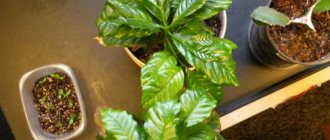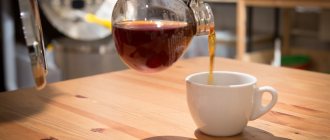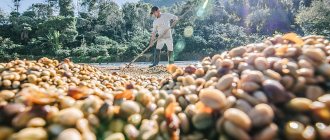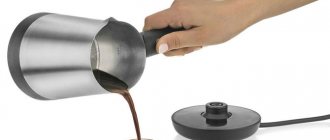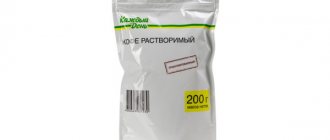March 15, 2012 Equipment and accessories
- Tamper
is a special press for tamping ground coffee before preparing espresso in a carob coffee maker. One of the barista's tools. It comes in a variety of sizes, with a flat or oval base, and is made from a variety of materials. The taste of the prepared drink largely depends on the quality of the tempera and the correct use of it.
How to choose and where to buy a tamper for a carob coffee maker
Proper tempering of the coffee tablet is one of the main components for obtaining the perfect espresso.
If you immediately bought a semi- or professional carob coffee maker, then most likely it came with a normal tamper for its horn. But, firstly, this is not always true, and secondly, you may want to change the supplied tamper to a better one or a different shape. For home coffee makers with their “improvers” and double baskets, tampering is not as important as for single-bottom filters of professional machines, however, the complete tamper usually does not stand up to criticism. A couple of examples right off the bat: Delonghi EC145/155, ECO 310/311, as well as some other Delonghi models are equipped with a fungal tamper built into the body, and in Gaggia Viva the manufacturer suggests using the bottom of a measuring spoon as a tamper - both options are useless.
Download and print the template
First you need to decide on the size of the tamper
You need to start choosing a coffee tamper by measuring the internal diameter of the filters of your coffee maker, if this parameter is still unknown to you. Most home, entry-level coffee makers are equipped with 52 mm baskets. Some, such as Saeco Poemia or some Bork (Breville) models - 54 mm. Since the size of the tamper should be slightly smaller, they fit 51 and 53 mm tampers respectively.
| Diameter of suitable tempera | Examples of coffee makers | Examples of stores where to buy |
⌀ 49 mm | Despite the fact that on the Internet you can sometimes find advice about buying tampers with a diameter of 49 mm for Krups and Delonghi coffee makers, this is not so. Well, or very much for an amateur (there is a very large gap left between the distemper and the edges of the basket). Perhaps this myth dates back to the very old Delonghi models (even before the BAR series). In any case, I don't know of any coffee maker on the market today that requires a 49mm tamper. Maybe the old La Pavoni levers. And then in the comments they suggested that for the modern Elektra Micro Casa. | Can be bought on AliExpress |
⌀ 50 mm | Acceptable for Krups coffee makers, for example, XP3440 due to the too conical shape of standard filters. But it is better to buy a more universal 51 mm tamper. | If you really want to, search here |
⌀ 51 mm | All Delonghi horn pumps (from the oldest EC155 to the new EC685), all OEM China (Vitek, Polaris, Redmond, Kitfort, Scarlett). | Can be purchased from Doctor Coffee Machines and on Aliexpress |
⌀ 52 mm | Recommended for single-bottom baskets for two Delonghi servings (for example, “native” article number 7313286069 for EC145 and BAR series coffee makers) | |
⌀ 53 mm | Saeco Poemia, Saeco RI 8329, Gaggia Gran, Viva, Carezza, Bork C803, Breville 800 series | You can buy from Doctor Coffee Machines, Tasty coffee and AliExpress |
⌀ 57 mmor ⌀ 57.5 mm | Lelit PL41 (except for versions with PLUS in the article), PL42, several less popular Lelits, some models La Marzocco, La Cimbali, Innova. 57.5mm is better, but harder to find. | You can buy from Doctor Coffee Machines, Tasty coffee and AliExpress |
⌀ 58 mmor ⌀ 58.35 mm | Gaggia Classic, Rancilio Silvia, Ascaso Basic/Arc/Dream, Nuova Simonelli Appia and most professional carob coffee makers. 58.35mm is better, but harder to find. | You can buy it from Doctor Coffee Machines, Tasty coffee or Aliexpress. |
Types, types of tampers, what materials they are made from
Tampers are usually made of a steel base and a metal (steel, aluminum) or wooden handle. The handle can also be plastic, but this option is not immediately available. Just like all-plastic distempers. Personally, I prefer all-steel temperas; they are heavier (and weight means reliability and ease of tempering), and they are simply stronger. But yes, wood may feel nicer to the touch. Although this is a matter of taste.
The main thing in tempera is a mirror-like, perfectly flat surface. Here I can already hear - “how smooth, better than corrugated!”
Indeed, tampers differ in the shape of the working surface, and there are the following types:
- Corrugated, with circular grooves. I don’t know why such a tempera is better, and I don’t even know where it came from. If any of the readers have reliable information, please share it in the comments. In my personal experience, I did not find any advantages. But you can receive communion on Aliexpress.
- Convex outward (oval). Two subtypes: “American” bend , absolute elevation above the plane of the heel 1.661 mm;
- “European” bend – convexity by 3.355 mm. “Europeans” are either uniformly oval or trapezoidal, with a beveled “step”.
Such tampers were developed with the idea that often the breakdown of the coffee tablet goes along the edge, plus the baskets are narrowed downward. And the conical tamper allows you to make the layer of coffee in the filter at the edges a little larger, which is especially important for single baskets. This is a theory. I use a flat tamper for both single and double baskets. I personally find it much more difficult to compact oval ones without distortion in the horizontal plane.
- Classic, flat surface. I'm for her.
But I heard that there are dynamometer tampers and tampers with limiters, what are they?
Yes, there are, for example, on Aliexpress you can buy it for not much more than a regular one. Torque (sometimes mistakenly called dynamic, which is, of course, incorrect) tampers are equipped with a calibrated spring inside the handle, which clicks when a force of approximately 15 kg is reached. Made with the message that effort is extremely important, and the tempera will tell you when you achieve what you need.
I am skeptical about such tempera. I tried it and found it more difficult to achieve even tamping with a torque tamper. What bothered me the most was the loose, loose design of the handle with this same spring inside. And I don’t have any problems with assessing effort anyway.
The second “innovative” option for improving the classic design is a tamper with a limiter. This tamper has an expanding stop above the working surface, a visor that rests on the portafilter, allowing compaction without distortion. The depth of immersion of the tamper into the coffee basket is adjustable, that is, you can set it according to your weight of the coffee tablet and simply press until it touches the walls.
- Glass tea set
It sounds tempting and seems to actually work. But after the test, I still refused to use this. Perhaps it was my crooked hands, but the shape of the handle was uncomfortable for me. And as I understand it, all tampers with limiters are produced with just such a flat handle. I couldn't get the hang of it. If you wish, you can buy communion in the Taystee online store.
What to give to yourself and your coffee machine? Espresso accessories
A reputable barista owns a whole arsenal of devices and accessories. They not only demonstrate the taste and level of “initiation” of their owner into the mysteries of true espresso.
Their main task is to make the process of making coffee convenient and harmonious.
We talk about what devices and gadgets should be next to the coffee machine in this article.
Let's start with the general list:
- coffee grinder
- horn (holder, portafilter)
- tempera
- tempera station
- knock box
- pitcher
- cleaning products
- water filter
- and, of course, proper coffee
We will omit here a discussion of coffee machines as one of the main components in creating real espresso. Let's move straight to the first item on our list.
Coffee grinder
“First buy a coffee grinder, and with the change, buy a coffee machine.” Such recommendations can be heard from avid coffee drinkers. The coffee grinder is really very important. Extraction—that is, the transfer of flavor and aromatic components from coffee beans into water—depends on how the coffee is ground. Without a good grinder, even a good coffee machine will produce mediocre espresso.
Ground coffee quickly loses its aromatic substances. The count here is not in months and days, but in minutes. You need to grind coffee for espresso immediately before preparation.
The idea of using ground coffee in packs bought at the store will have to be abandoned.
A good coffee grinder allows you to finely regulate the degree of grinding. It is adjusted depending on the type of coffee, air humidity, and personal taste preferences. Setting the grind is perhaps one of the most difficult steps in making espresso. The degree of grinding (coarser - finer) significantly affects the taste of the same coffee: the finer the grinding, the slower the extraction. Note: the grinding is reduced if the coffee is very sour and increased if it is very bitter.
Horn (holder, portafilter)
This is one of the main parts in the design of a carob coffee machine. Therefore, we will discuss it separately. The holder must be massive and steel. This is important for temperature stability, which affects the extraction process. Holders come with baskets for one and two servings. And, accordingly, with one and two spouts.
There is no need to buy this accessory separately: the holder is supplied with the coffee machine, complete with a single and double basket (filter).
However, lovers of designer shapes and exquisite tactile sensations can buy an additional portafilter. For example, with a cherry or plum wood handle from Weinmann. Please note that different manufacturers use horns of different diameters: 49, 53, 57, 58 mm. The most common diameter is 58 mm - the working diameter of the popular E61 type brew group.
Temper
A tamper is a barista tool that helps to properly tamp the coffee in the basket. Tempering (tempering) - the distribution of ground coffee in the basket - is an important step in making espresso. The coffee should be distributed throughout the basket as evenly as possible and without lumps.
If the coffee powder is not compacted evenly (or skipped completely for the sake of experimentation), the water, following the path of least resistance, will quickly spill into the cup, leaving most of the aromatic substances in the powder. The coffee will turn out so-so, with pronounced burnt notes.
Simple plastic tampers are usually included with most coffee machines. However, these are rather unsightly products and are not very convenient to use.
Manufacturers of carob coffee makers honestly admit this. For example, in the instructions for Vibiemme coffee machines it is written: “The tamper that comes with your coffee machine is “sub-standard” (that is, the quality leaves much to be desired). Therefore, contact your dealer to purchase a quality tempera..." In addition, the plastic tamper looks... hmm, rustic next to the sparkling coffee machine and coffee grinder.
Stainless steel tampers are considered the most convenient. This tamper is heavy and comfortable to hold in your hand. It is also stable, has a durable sole that does not scratch.
There are tampers with a dynamometer. They allow you to set precise pressure for temping. This type of accessory is especially useful for coffee shops where several workers need to temp with the same force. When choosing a tamper, consider the diameter of the holder of your coffee machine.
Temperature station
To make tempering fun, the tempering station was invented. This device allows you to apply the necessary force when tamping coffee without fear for furniture and the spout of the coffee horn. In addition, the tamper can be stored in the station. The appearance and materials of tampers and distemper stations will please even a sophisticated esthete.
Knock box
After preparing a cup of aromatic espresso, raw, waste coffee remains. And the question arises of how to get it and where to place it. Answer: knock box. This is a device for knocking out and collecting waste coffee, a neat trash can for espresso waste.
Structurally, it is a container with soft rubberized edges and a crossbar. With light blows of the holder against the crossbar, the coffee tablet is knocked out into the box. The used coffee stays there for several hours without causing any problems.
Knock boxes can serve as a stand for a coffee grinder or coffee machine. Then they are equipped with a drawer for collecting coffee. Both convenient and beautiful.
Pitcher
In the pitcher, milk is whipped with steam into foam for preparing cappuccino, lattes and other milk-coffee compositions.
If you buy a coffee machine only for making espresso, you can do without a pitcher. But this, you see, is a rare case. Therefore, you need to remember about the pitcher and include it in the list of required accessories when purchasing a coffee maker. Pitchers are not included in the factory kit.
Descaling and coffee oil removers
Regular cleaning of your coffee machine is very important. Not only because you won't void your warranty if you clean your machine regularly, but also because calcification and coffee fat deposits gradually degrade the taste of your coffee.
Scale is the most common reason for coffee machines to fail. Therefore, in advanced cases, you will have to contact specialists. In most cases, repairs will consist of... professional cleaning! To clean the system and avoid clogging it with limescale formations, disassembling the machine is required, including removing the boiler and disassembling the pipelines. Coffee machine manufacturers recommend using special descaling products.
Coffee oils (also called coffee fat) settle in the brew group over time and become rancid. Which naturally gives coffee the taste of old, rancid beans. In order to prevent such developments, it is necessary to clean the group approximately once a month using a special means for removing coffee oils.
By the way, coffee oils also accumulate on the portafilter, especially in the spout. Therefore, it also needs to be cleaned - once a week or two, depending on the intensity of use, by soaking it overnight in a container with water and a tablespoon of special product.
Water filter
Water for coffee must be guaranteed to be clean - free of impurities and odors that can be found in public water supply. Therefore, a carob coffee machine definitely needs a water filter if it is directly connected to the water supply.
If you are using a self-contained tank, it is wise to fill it with either filtered tap or bottled water.
Proper coffee
For espresso you need the right coffee. Coffee blends (mixes) are prepared specifically for preparation in carob coffee makers. Pay attention to the corresponding icons and inscriptions on packages of coffee beans (as already noted, we do not buy ground coffee).
Never use flavored coffee for espresso!
This may be hazardous to your health.
As for brands, Stoll Espresso recommends Cagliari, BrasilOro and Danesi.
Are there also coffee levelers?
Tampers should not be confused with levelers, or rather the opposite. On Aliexpress, levelers are often passed off as tampers, although they are a separate tool. They look something like the photo on the right; on Ali they are often called “temper macaroni.” As planned, they help to level the initial pile of coffee before direct compaction. They are quite possible to use, they really work and not only equalize coffee, but also allow you to break up lumps, however, only those on top of the tablet, not in the lower layers. Due to the fact that the level of lowering of the metal base (heel) into the basket varies, it is possible to make a kind of screw-in press, which, when it reaches the stop on the sides of the basket, forms both the desired thickness of the tablet and the shape. Despite the fact that this is not a tamper, many people only use a leveler and never even pick up a tamper.
By the way, the popular name for such a distributor for coffee is “EIR” - One True Distributor .
It is believed that the ideal number of blades is 3. It is important that the shape of the blades is not very aggressive, so as not to rake the coffee behind you, but rather to level it. Good and inexpensive options for all common basket sizes are here. There are also double-sided ones, but this is definitely superfluous.
The dream of every owner of professional 58 mm baskets is to have a Motta 58.5 distributor. These half millimeters provide a precise fit to the edges, just like the corresponding tempera. But besides Motta, no one else makes them (from those that we can at least in theory get). There used to be Classic Pro, but they disappeared. Yes, in fact, Motta is practically impossible to find; I haven’t seen it on sale for a long time.
Verdict: Which tempera is best?
Considering that there are different types of coffee tampers, I personally prefer all-steel, heavy ones with a flat surface for a comfortable, classic grip. I didn’t check out the dynamometer ones and with the limiter. It is also quite possible, and even more convenient, especially for beginners, to use the “EIR leveler”; in this case, you can skip the distemper.
PS By the way, to complete the picture, I would also like to draw attention to such little things as a stand for the tempera, where it can be stored “at rest” (a less useful accessory), as well as mats for tempering (more useful, as an example - this one).
These accessories do not affect the taste in any way, but they allow you to add a bit of convenience, and in the case of a corner rug, protect the table surface. Of course, it’s usually a pity to have a home countertop, if it’s not made of stone, but laying it on a towel or cutting board is not the same level
